Layman D. Biology Demystified: A Self-Teaching Guide
Подождите немного. Документ загружается.

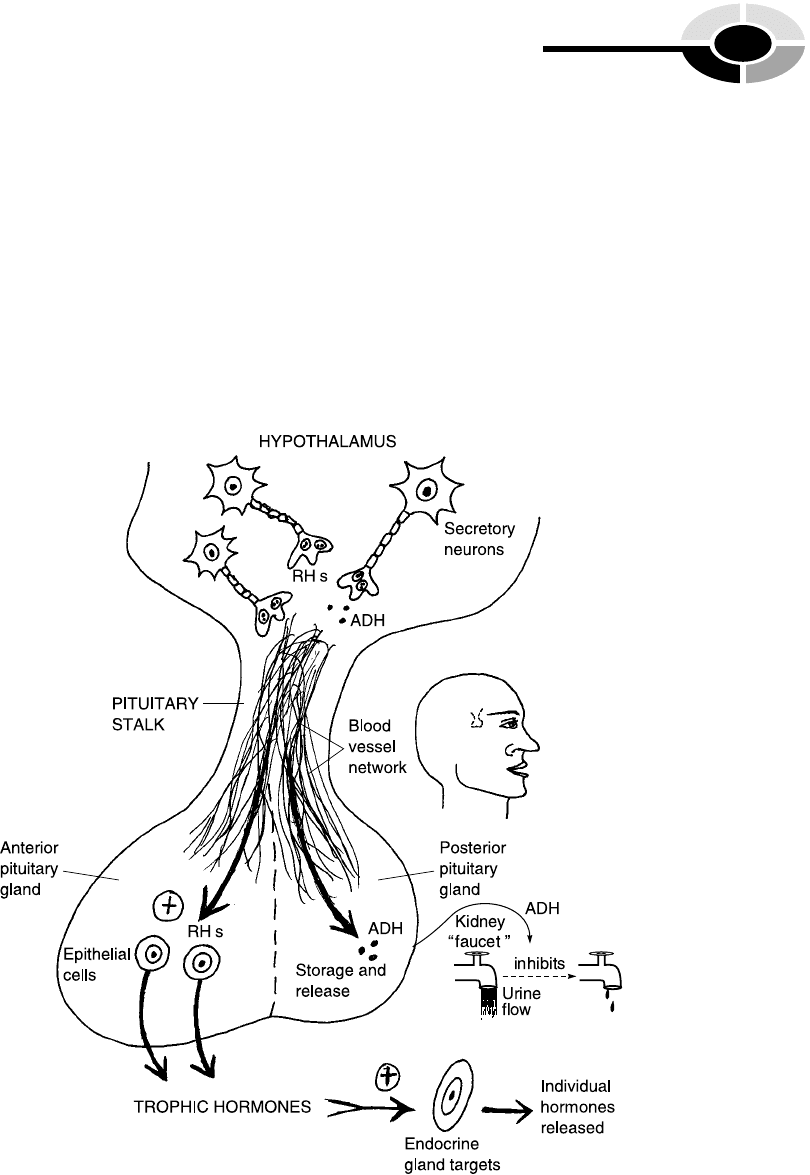
ostasis. Located just below the hypothalamus is a narrow, funnel-shaped
pituitary (pih-TWO-eh-tear-ee) stalk. This hollow stalk is attached to the
top of the pituitary body. The front of the pituitary body is called the anterior
pituitary gland, while the back is called the posterior pituitary gland. The
exact Latin translation of the word pituitary becomes evident from a look
at Figure 15.2. It literally ‘‘pertains to mucus (MYOO-kus) or phlegm (flem).’’
This term derives from the fact that the pituitary body is located just above
and behind the nose. Hence, it was only logical for the ancient anatomists to
think that the pituitary was the source of the ‘‘slime’’ (mucus) that sometimes
leaks from your nose when its interior is ‘‘inflamed’’ (phlegm)!
CHAPTER 15 Glands and Messengers 267
[13:26 13/6/03 N:/4058 LAYMAN.751/4058-Alltext.3d] Ref: 4058 Layman: Biology Demystified All-text Page: 267 1-388
′
′
Fig. 15.2 The pituitary stalk: A neuroendocrine connection.

Even though we dwellers of the 21st century realize that the pituitary body
is not some kind of channel that carries mucus from the brain down into the
nose, we do recognize that there is definitely a hypothalamus–pituitary con-
nection. The main connection is through the pituitary stalk. But instead of
carrying mucus or phlegm, the pituitary stalk contains a network of tiny
blood vessels that run down from the hypothalamus into the pituitary body.
In addition to vital control centers, the hypothalamus also contains an
amazing collection of secretory (SEE-kreh-tor-ee) neurons – neurons that
secrete hormones or hormone-like substances. These hormones (or hor-
mone-like substances) are secreted into the tiny blood vessels flowing down
through the pituitary stalk. Thus, the pituitary stalk (and its collection of
blood vessels) creates an important neuroendocrine connection. This is
because the hypothalamus is generally considered part of the nervous system,
while the pituitary body and its two glands (anterior pituitary and posterior
pituitary) are classified as members of the large endocrine gland system.
One group of secretory neurons produce antidiuretic (an-tee-die-yuh-RET-
ik) hormone. Antidiuretic hormone, abbreviated as ADH, is named for its
primary function. ADH helps the kidney retain water due to its effect
‘‘against’’ (anti-) too much ‘‘urine passing through’’ (diuret) and out of the
body. Although ADH is actually secreted by the neurons in the hypothala-
mus, the hormone molecules travel down through the blood vessels in the
pituitary stalk, and are then stored by the posterior pituitary gland and later
released into the general bloodstream. [Study suggestion: Look at the ‘‘kidney
faucet’’ model in Figure 15.2. How does the definition of ADH help explain
the turning off of the faucet from full blast to a slow drip?]
RELEASING HORMONES AND TROPHIC HORMONES
The largest group of secretions coming from the hypothalamus have no
direct connection to ADH. These other secretions are called the releasing
hormones (RHs). The releasing hormones (RHs) are secreted into the network
of tiny brain blood vessels coursing down through the pituitary stalk. The
transported RHs finally enter the anterior pituitary gland (rather than the
posterior pituitary gland). The releasing hormones get their name from their
primary function. They literally stimulate the release of a variety of trophic
(TROHF-ik) hormones from the epithelial cells of the anterior pituitary
gland.
Remember (Chapter 14) that troph means ‘‘nourishment’’ in the sense of
stimulating something. Trophic hormones, therefore, are hormones secreted
by the anterior pituitary gland that have individual endocrine glands as their
[13:26 13/6/03 N:/4058 LAYMAN.751/4058-Alltext.3d] Ref: 4058 Layman: Biology Demystified All-text Page: 268 1-388
PART 4 Anatomy and Physiology of Animals
268
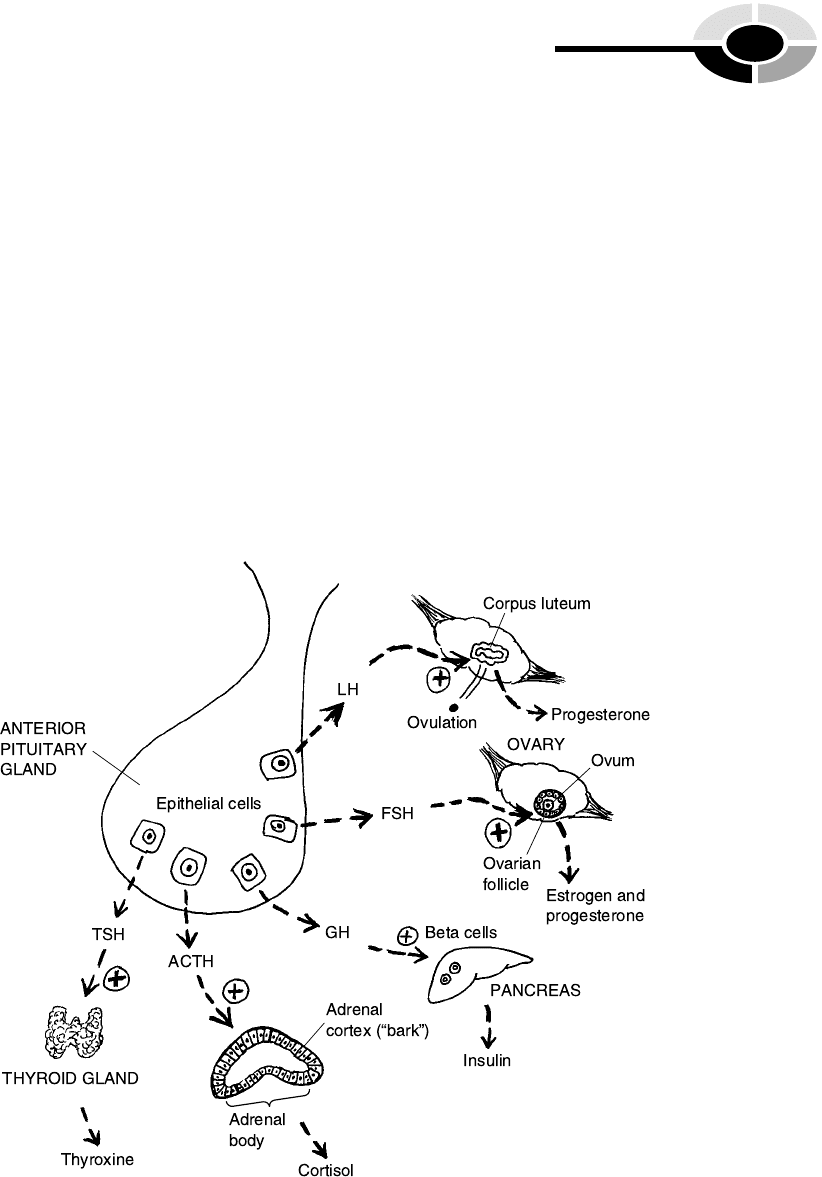
main targets for ‘‘nourishment’’ or stimulation. Figure 15.2 outlined the
highly orderly three-step process:
1. A particular releasing hormone (RH) is put out by the hypothalamus.
2. Each RH passes down through the pituitary stalk and triggers the
release of a certain trophic hormone.
3. Each trophic hormone in turn enters the general bloodstream and
stimulates a particular individual endocrine gland target to secrete its
own hormone.
Figure 15.3 shows pictures of the major endocrine gland targets being
stimulated by various trophic hormones from the anterior pituitary. Take,
for instance, the thyroid (THIGH-royd) gland in the front of the neck. The
thyroid gland is named for its ‘‘resemblance’’ (-oid) to a broad ‘‘shield’’
(thyr). The thyroid is stimulated or ‘‘nourished’’ by thyroid-stimulating hor-
mone, abbreviated as TSH. The thyroid gland is stimulated by TSH to
CHAPTER 15 Glands and Messengers 269
[13:26 13/6/03 N:/4058 LAYMAN.751/4058-Alltext.3d] Ref: 4058 Layman: Biology Demystified All-text Page: 269 1-388
Fig. 15.3 Some major trophic hormones and their endocrine targets.

increase the rate of secretion of its own individual hormone, thyroxine (thigh-
ROCKS-in). Thyroxine, in turn, circulates throughout the bloodstream to
affect most of the body cells. Thyroxine, for example, increases the basal
(BAY-sal) metabolic rate or BMR: that is, the rate at which body cells
burn calories during their metabolism under resting or ‘‘basal’’ conditions.
[Study suggestion: From its effect upon BMR, how would you expect thyr-
oxine to influence oral body temperature? Why?]
The name of a second important trophic hormone is a real tongue-twister!
Its name is adrenocorticotrophic (uh-dree-noh-kor-tuh-koh-TROHF-ik) hor-
mone, simply abbreviated as ACTH. The adrenocortico- part of the hor-
mone’s name comes from its endocrine gland target – the adrenal (uh-
DREE-nal) cortex. Just as the cerebral cortex (Chapter 14) literally forms a
thin ‘‘bark’’ over the surface of the cerebrum, the adrenal cortex is an endo-
crine gland forming a thin ‘‘bark’’ (cortex or cortico-) over the surface of the
adrenal body. This body is a curved, stocking cap-shaped structure that lies
‘‘toward’’ (ad-) the top of each ‘‘kidney’’ (renal).
The adrenal cortex or thin outer bark of the adrenal body secretes the
hormone cortisol (KOR-tih-sol). Cortisol raises the blood glucose level when-
ever it is low, and it also acts to relieve the symptoms of tissue inflammation.
A third trophic hormone is called growth hormone (GH). Growth hor-
mone, as its name states, circulates to most of the body cells and stimulates
their growth by promoting such processes as protein synthesis and cell divi-
sion. But the specific target gland of its trophic influence are the beta (BAY-
tuh) cells of the pancreas. The beta cells are well known because they secrete
the hormone, insulin (IN-suh-lin). Insulin is absolutely critical for human
survival, because it helps to transport glucose out of the bloodstream, thereby
feeding the tissue cells.
A fourth trophic hormone is follicle-stimulating hormone (FSH). You may
bring back to mind (Chapter 13) the ‘‘little bags’’ or hair follicles within the
skin. There is another type of ‘‘little bag’’ or follicle within the ovaries (OH-
var-ees) or ‘‘eggs’’ (ova) of females. The ovarian (oh-VAIR-ee-an) follicles are
tiny bags or sacs within the ovaries. Under the stimulating effect of FSH, they
increase their secretion of the two hormones, estrogen (ES-troh-jen) and
progesterone (proh-JES-ter-own). Estrogen stimulates the development of
so-called secondary sex characteristics in the female, such as a higher voice
and softer skin. Progesterone prepares the female body for a possible preg-
nancy.
A fifth trophic hormone, luteinizing (LEW-tuh-neye-zing) hormone or LH,
also acts upon the female ovary. It triggers a rupture of the mature ovarian
follicle, thereby causing ovulation (ahv-you-LAY-shun) – the release of a
‘‘little egg’’ (ovul) into the abdominal cavity. But luteinizing hormone derives
[13:26 13/6/03 N:/4058 LAYMAN.751/4058-Alltext.3d] Ref: 4058 Layman: Biology Demystified All-text Page: 270 1-388
PART 4 Anatomy and Physiology of Animals
270
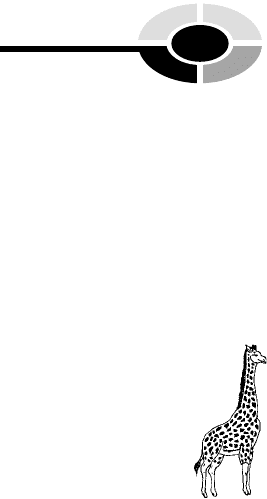
its name from the corpus (KOR-pus) luteum (LEW-tee-um) or ‘‘yellow body’’
that is still left within the ovary after ovulation. LH thus indirectly has a
luteinizing or ‘‘yellowing’’ effect, creating a yellowish body (corpus luteum)
that secretes lots of progesterone (and some estrogen).
THE SYMPATHETIC NERVE–ADRENAL CONNECTION
In addition to the hypothalamus–pituitary connection, there are other exam-
ples of neuroendocrine relationships. Prominent among these are the partners
in the ‘‘Fight-or-Flight’’ Stress Response. Whenever a human or other verte-
brate is under severe stress, then this ‘‘Fight-or-Flight’’ Response automati-
cally engages. The vertebrate gets ready to either stand its ground and fight for
survival, or else take flight and simply run away from encroaching danger.
The sympathetic nerves are critical elements of the ‘‘Fight-or-Flight’’
Response, as are both the adrenal cortex and the adrenal medulla (meh-
DEW-lah). The adrenal medulla lies in the ‘‘middle’’ (medull) of the adrenal
body, whereas the adrenal cortex forms a thin bark around it. Figure 15.4
illustrates how the sympathetic nerves leave the hypothalamus area and carry
nerve impulses (action potentials) down into the adrenal medulla. The sym-
pathetic nerves are literally the ‘‘suffering’’ (path) ‘‘with’’ (sym-) nerves,
reflecting their central role in carrying out the body’s response to alarm or
stress.
The sympathetic nerve endings stimulate epithelial cells within the adrenal
medulla to increase their secretion of the two related hormones, epinephrine
(ep-ih-NEF-rin) and norepinephrine (NOR-ep-ih-nef-rin). These two hor-
mones are given the alternate names of adrenaline (ah-DREN-uh-lin) and
noradrenaline (NOR-ah-dren-ah-lin). Epinephrine (adrenaline) is secreted
from the ‘‘adrenal’’ (hence the adrenaline name), which is located ‘‘upon’’
(epi-) the ‘‘kidney’’ (nephr). Norepinephrine (noradrenaline) is ‘‘normally’’
(nor-) secreted by the adrenal medulla, along with its close chemical cousin
epinephrine (adrenaline), but in much smaller amounts.
Epinephrine circulates widely throughout the bloodstream and generally
stimulates the heart to beat faster and harder, and the blood vessels to con-
strict (narrow), thereby creating a rise in blood pressure. Faster and stronger
heart contractions, and a higher blood pressure to push the blood through
the vessels more rapidly, help the body under stress to either flight or flee
from danger. This danger is usually recognized first within the brain, which
then engages the ‘‘Fight-or-Flight’’ Response involving the sympathetic
nerves and adrenal hormones. This close functional inter-relationship may
thus be called the sympathetic nerve–adrenal connection.
CHAPTER 15 Glands and Messengers 271
[13:26 13/6/03 N:/4058 LAYMAN.751/4058-Alltext.3d] Ref: 4058 Layman: Biology Demystified All-text Page: 271 1-388
5, Order
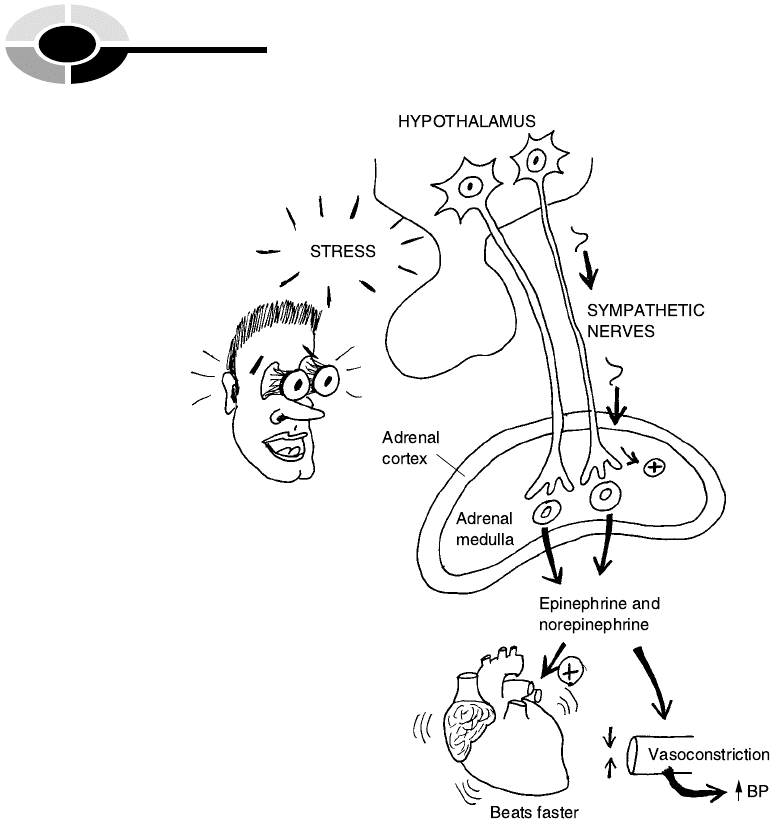
Hormones (First Messengers) And Their
Partners Inside Cells
We have now traced the operation of several examples of the neuroendocrine
system. Within such nerve–gland connections, it is often difficult to tell which
part of the connection (the nerve or the gland) comes first in communicating
and controlling various aspects of homeostasis. In certain instances, however,
the endocrine system, alone, provides the message for initiating specific body
responses to stimuli (STIM-you-lie) or ‘‘goads.’’
[13:26 13/6/03 N:/4058 LAYMAN.751/4058-Alltext.3d] Ref: 4058 Layman: Biology Demystified All-text Page: 272 1-388
PART 4 Anatomy and Physiology of Animals
272
Fig. 15.4 ‘‘Fight-or-Flight’’: The sympathetic nerve–adrenal connection.
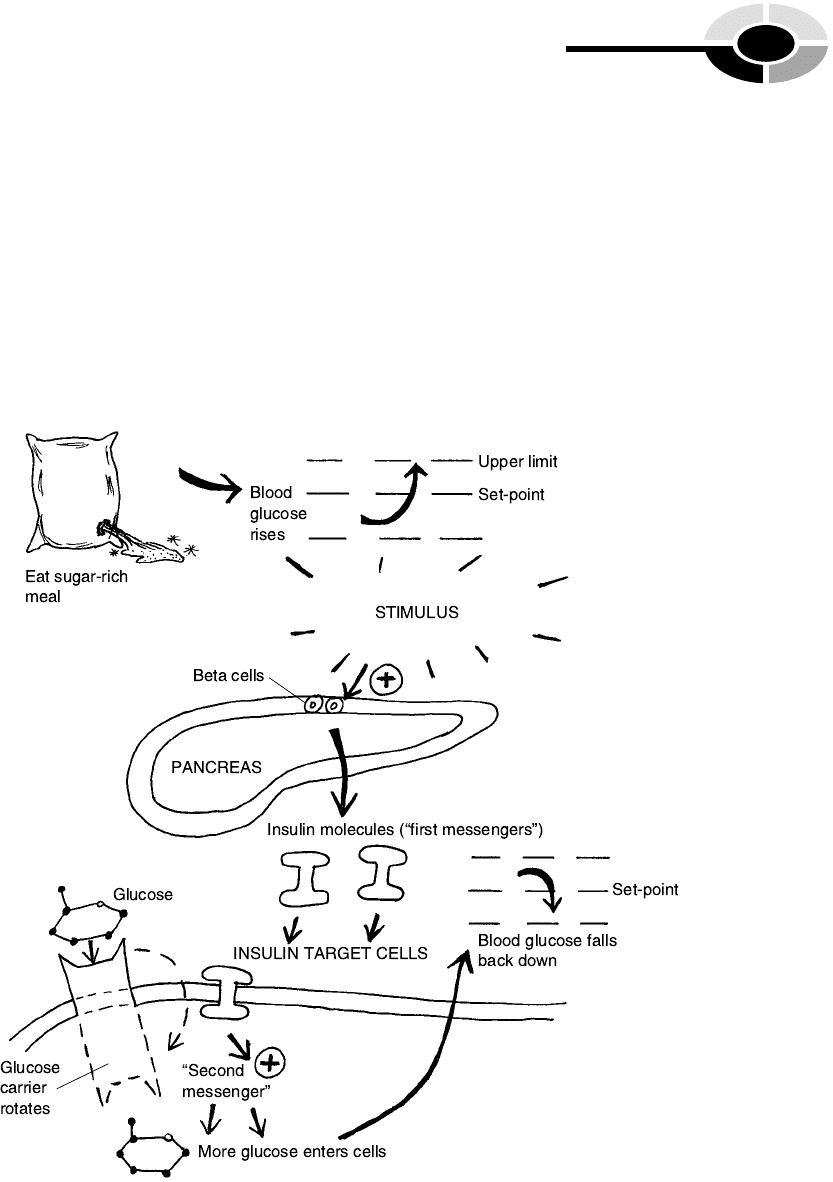
INSULIN SECRETION AND BLOOD GLUCOSE
CONCENTRATION
An important example of such hormone-directed responses is the stimulation
of the beta cells of the pancreas by a rise in blood glucose concentration. As
Figure 15.5 shows, eating a sugar-rich meal soon results in a rise in blood
glucose concentration above the set-point level, and towards the upper limit
of its normal range. There is only one major gland (the beta cells of the
pancreas) that is strongly excited by this particular stimulus.
CHAPTER 15 Glands and Messengers 273
[13:26 13/6/03 N:/4058 LAYMAN.751/4058-Alltext.3d] Ref: 4058 Layman: Biology Demystified All-text Page: 273 1-388
Fig. 15.5 Insulin and ‘‘Second Messengers’’ within its target cells.

The beta cells respond by increasing their rate of secretion of insulin
molecules into the bloodstream. Insulin hormone molecules are, then, the
‘‘First Messengers’’ within the bloodstream. By this we mean that the
presence of so many insulin molecules in the blood sends a powerful ‘‘First
Message’’ to the rest of the body. In words, this chemical message might read:
‘‘Hey! Listen up, target cells! The blood glucose concentration has risen near
the upper limit of its normal range! Let’s do something about it!’’
This ‘‘First Message’’ has an effect upon many cells in the body. But the
chemical signal is especially strong for the main insulin target cells: adipocytes
(AH-dih-poh-sights) or ‘‘fat’’ (adipo-) ‘‘cells,’’ hepatocytes (heh-PAT-oh-
sights) or ‘‘liver’’ (hepat) ‘‘cells,’’ and skeletal muscle fibers. When an insulin
molecule binds (attaches) to the plasma membrane of one of these target cells,
it has essentially delivered the ‘‘First Message.’’
But the insulin molecule, like most hormone molecules, is far too large to
actually enter the target cells. Instead, it operates by activating a ‘‘Second
Messenger’’ – one that lies within the target cell. The ‘‘Second Messenger’’ is
an intracellular helper molecule. The ‘‘Second Messenger’’ is thus the chemi-
cal that actually causes a change in target cell metabolism. In an insulin
target cell, for example, ‘‘Second Messengers’’ activated by the binding of
insulin to the cell surface help carry out two important changes in cell meta-
bolism:
1. These molecules speed up the glucose carrier proteins that act to aid or
‘‘facilitate’’ the diffusion of glucose out of the bloodstream, and into
the target cells.
2. Intracellular ‘‘Second Messenger’’ molecules activate a key enzyme
required for glycolysis – the utilization of glucose for making ATP
energy.
As a result of these two intracellular processes directed by ‘‘Second
Messengers,’’ glucose leaves the bloodstream in large quantities, enters the
insulin target cells, and gets broken down for free energy. Finally, the blood
glucose concentration falls back toward its set-point level.
Endocrine Diseases As Uncontrolled Secretion
When endocrine glands secrete their hormones at a ‘‘normal’’ (normo-) rate,
we say that there is a normosecretion (NOR-moh-see-KREE-shun) of the
hormones. Consider, for example, a normosecretion of insulin. In this case,
[13:26 13/6/03 N:/4058 LAYMAN.751/4058-Alltext.3d] Ref: 4058 Layman: Biology Demystified All-text Page: 274 1-388
PART 4 Anatomy and Physiology of Animals
274

[13:26 13/6/03 N:/4058 LAYMAN.751/4058-Alltext.3d] Ref: 4058 Layman: Biology Demystified All-text Page: 275 1-388
there is just enough insulin secreted to help glucose diffuse out of the blood-
stream, and into the target cells, so that a condition of normoglycemia (NOR-
moh-gleye-SEE-me-uh) prevails. Normoglycemia is ‘‘a blood condition of ’’
(-emia) ‘‘normal’’ (normo-) ‘‘sweetness or glucose’’ (glyc). When the pancreas
(and its beta cells) are of a normal size and activity level, then there is a
normosecretion of insulin, and a resulting state of normoglycemia within the
bloodstream (see Figure 15.6, A).
What happens if a gland atrophies (AH-troh-fees) – shrinks in size – or
some of its cells die or are removed? Since just a shrunken mass of epithe-
lial cells is left alive and functioning, gland hyposecretion (HIGH-poh-see-
KREE-shun) results (see Figure 15.6, B). Hyposecretion is literally a con-
dition of ‘‘deficient or below normal’’ (hypo-) secretion of some particular
hormone.
To illustrate, consider what happens if many of the beta cells become
damaged or die, due either to genetic mutations or to an overall atrophy
of the pancreas. One serious disease that could result is diabetes (die-uh-BEE-
teez) mellitus (MEL-uh-tus). Diabetes mellitus exactly translates to mean a
‘‘honey-sweet’’ (mellit) ‘‘passing through’’ (diabetes) of urine from the body.
Persons suffering with Diabetes mellitus often have beta cells that do not
produce enough normal insulin to significantly reduce the blood glucose
level. As a result of such long-term hyposecretion of insulin, too much glu-
cose is left behind in the bloodstream.
After glucose builds up over time, a state of hyperglycemia (HIGH-per-
gleye-SEE-mee-ah) follows. Hyperglycemia is an ‘‘excessive or above nor-
mal’’ (hyper-) concentration of glucose within the bloodstream. With so
much glucose staying in the blood, eventually some of it is excreted into
the urine by the kidneys. The result is technically called glycosuria (gleye-
koh-SUR-ee-ah) or ‘‘an abnormal condition of ’’ (-ia) ‘‘glucose’’ (glycos)
within the ‘‘urine’’ (ur).
Finally, let us ponder the condition of glandular hypertrophy (enlarge-
ment) or the presence of gland tumors (Figure 15.6, C). With so many addi-
tional epithelial cells being present, the enlarged gland often has a
hypersecretion (HIGH-per-see-KREE-shun) of its hormones. This means, of
course, that there is an excessive or above normal rate of hormone secretion
by the gland. Extreme physiological results often occur.
Let us apply this to the pancreas and its secretion of insulin. When there is
a marked enlargement (hypertrophy) of the pancreas and its beta cells, then
there is also a marked hypersecretion of insulin. Too much glucose is
removed from the bloodstream and transported into the body target cells.
With so much glucose gone, severe hypoglycemia (HIGH-poh-gleye-SEE-
mee-ah) may occur. [Study suggestion: Following the pattern set by the pre-
CHAPTER 15 Glands and Messengers 275
1, Disorder
2, Disorder
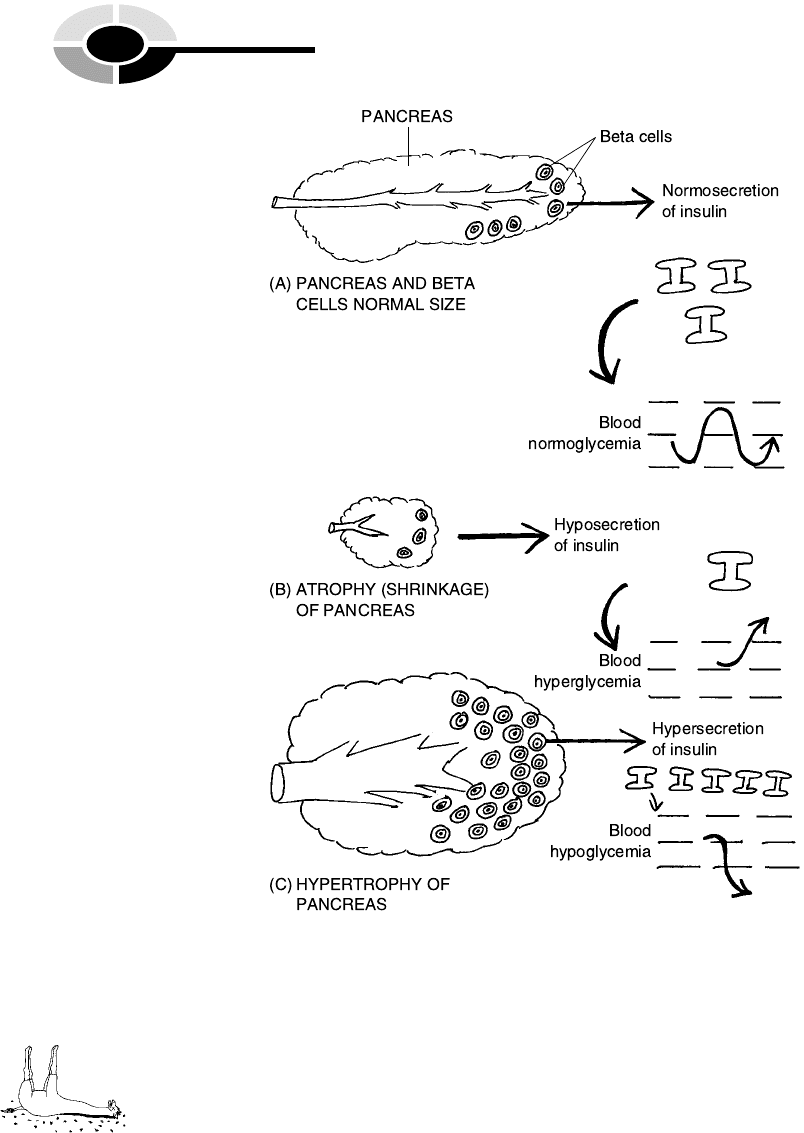
ceding paragraphs, try to write the literal English translation of hypoglyce-
mia on a piece of paper. Check your translation with a friend.]
Insulin shock or coma can result from a severe and prolonged hypoglyce-
mia. The neurons in the brain are completely starved of glucose, their major
fuel. The person goes into coma or the ‘‘deep sleep’’ of brain failure, and may
lose consciousness and die.
[13:26 13/6/03 N:/4058 LAYMAN.751/4058-Alltext.3d] Ref: 4058 Layman: Biology Demystified All-text Page: 276 1-388
PART 4 Anatomy and Physiology of Animals
276
Fig. 15.6 Uncontrolled secretions and glandular diseases.
3, Disorder
